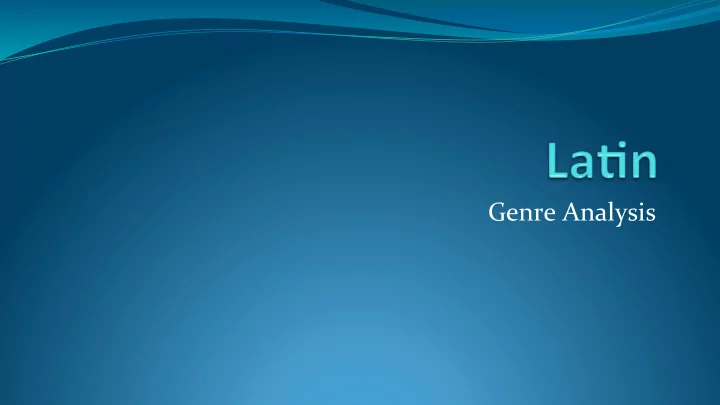

Genre Analysis
History of La,n Music in the USA (PBS) Pt1
History of La,n Music in the USA (PBS) Pt2
History of La,n Music in the USA (PBS) Pt3
La,n Music – in American & Western culture Began as a fusion of: Indigenous & Andean music from the Americas African rhythms Jazz, Blues, and R&B influence
La,n America - “The New World” Central & South America becomes Latin America after the arrival of explorer, Christopher Columbus. Colonisation and slavery would follow bringing new musical traditions & influence This encounter marks the beginning of Latin American music history
African Rhythmic influence Polyrhythms & Syncopation lie at the heart of the music African derived percussion instruments have also helped create many rhythms and styles such as: Congas Bongos Bells Shakers Claves Timbales etc.
African-American Influence The full picture of African influence also includes the later relationship with African-American music in from the early 1900’s such as Jazz Popular American Music and Latin would influence and inspire each other since the early 1900’s
“Lemon meringue pie” Afro-Cuban Rhythm in the bottom African instruments contribute to the underlying rhythm Jazz in the top Instrumentation borrowed from Jazz and R&B would begin to play chords, melodies, counter-melodies and riffs or repetitions of sounds over the top of the top.
Tradi,onal styles A look at the many colours, flavours and ideas across Latin America…
The South Argen,na Tango – The famous partner dance music Arose as a result of Social conditions and class divisions. Chile & Uruguay Murga – Musical theatre and Carnivale music
Music of the Andes: Bolivia, Ecuador & Peru Usually played with; Panpipes, Bombo drums and the Charango
The North Colombia & Venezuela Colombian Cumbia heavy percussion large gaita flutes Musica Llanera , inspired by warm country life in the plains above the Amazon, combining; Harp, Maracas and Cuatro & Bandola
Brazil Portuguese language and Fado music influence Home to the famous Samba deriving from the slave trade of West Africa Cavaquinho (Portuguese Ukelele) often incorporated
Cuba The famous Salsa evolved from Cuba’s traditional Son originally played with Guitars, Claves and Maracas Puerto Rico Plena & Bomba Spanish, African & Indigenous combined
Mexico Ranchera, Flamenco & Mariachi During troubling times of the Mexican Revolution, Ranchera music became a way to promote Mexican culture.
Paco De Lucia – Tico Tico
La,n American in Western Music The last century has seen an enormous exchange of influences between Western Popular music and Latin American…
1930’s – 50’s Afro-Cuban & La,n Jazz Cuban & Puerto Rican music in particular meets Jazz in parts of NYC Gives birth to many styles and dances including: The Rhumba Bossa Nova Mambo Salsa
1930’s – 50’s Afro-Cuban & La,n Jazz The Big 3 artists: Machito & His Afro Cubans Tito Rodriguez Tito Puente Other important developers: Mario Bauza Chano Pozo Dizzy Gillespie
1950’s – 70’s La,n influence in R’n’R Latin sounding melody & rhythm patterns surface in the works of: The Kingsmen The Beatles The Doors Rolling stones Ritchie Valens Santana
1950’s – 70’s Tejano (Tex-Mex) Born on the United States/ Mexico border, fusing traditional Mexican music with American Country and R&B Freddy Fender Selena Quintanilla
La,n Ballad (Bolero) Sensitive & often passionate romantic ballads often danced to as a waltz. Julio Iglesias Luis Miguel Enrique Iglesias Cristian Castro
Reggaeton Developed in Puerto Rico fusing traditional Bomba Jamaican Reggae and Dancehall Calypso from Trinidad and the Caribbean American Rap and Hip Hop Don Omar Ivy Queen
“La,n Pop” Generally refers to pop music with Latin American influence. Often refers to Pop Music from Latin America or sung by Latin Americans in the USA. Occasionally, the definition extends back to Latin Europe ie: Spain, Portugal, Italy & France.
La,n Pop - language Usually English & Spanish Also Portuguese, Italian and derivatives. Many international artists from France and Italy record Spanish versions of their songs for a larger audience.
La,n pop – Major Ar,sts: 70’s & 80’s onwards Luis Miguel Julio Iglesias Gloria Estefan Menudo Vicente Fernandez José Feliciano Gipsy Kings Zucchero Santana
Gloria Estefan – Mi Tierra
Santana – (Da Ye) Yaleo - Live
Zucchero – Love is all Around
La,n pop – Major Ar,sts: 90’s to today: Ricky Martin Shakira Eros Ramazzotti Juanes Thalía Enrique Iglesias Jennifer Lopez Christina Aguilera Pitbull
Los Del Rio - Macarena
Shakira – Whenever, Wherever
Instruments
Instruments 1 - Arpa llanera (harp of the Llanos) 2 - Cuatro (four-stringed guitar from the Llanos) 3 – Maracas 4 – Panpipes 5 – Acoustic Guitar 6 - Bombo (Indian drum from the Bolivian Andes)
Produc,on Vast array of style and instrumentation – well researched and aware Often Rhythmically complex & Instrumentally full Can it all fit? Importance of Percussion. In most genres percussion may be a background element, however in Latin it is usually one of the most if not the most important element in a song.
Produc,on Certain instruments may share or swap lead roles, Fusion or Combination of instruments achieves the rhythmic feel Major goal – Instruments meshing well together while allowing them all their own bit of “space” in the mix. Separation
Produc,on Certain instruments may share or swap lead roles, Fusion or Combination of instruments achieves the rhythmic feel Major goal – Instruments meshing well together while allowing them all their own bit of “space” in the mix. Separation EQ Additive & Subtractive Panning Use that Stereo field
The Mask – Cuban Pete
Recommend
More recommend